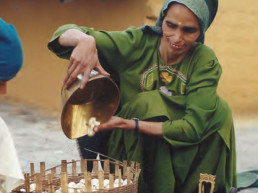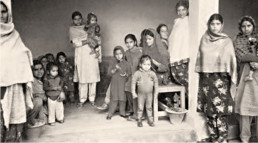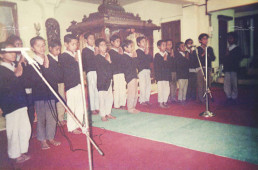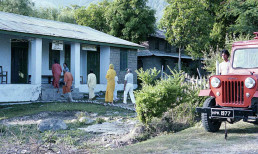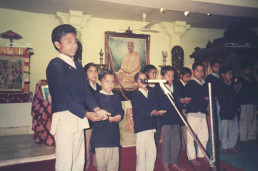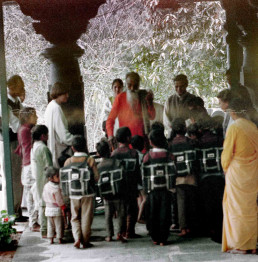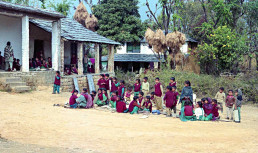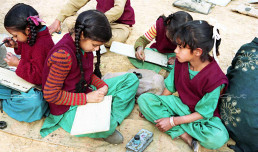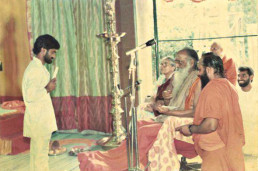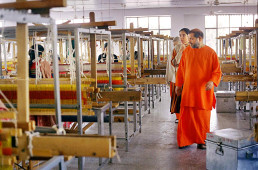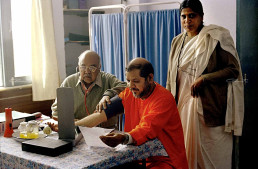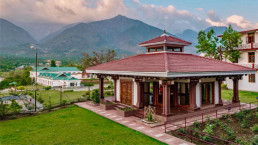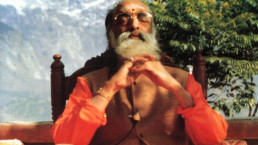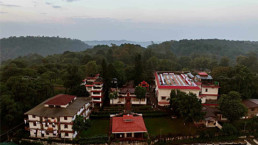Pujya Gurudev used to describe true love as a dynamic giving, not a passive taking. One of his main objectives in starting the ashram at Sidhbari was to uplift the lives of the Pahadis, the natives of the Himalayan region who had served the saints and sages in the mountains of yore.
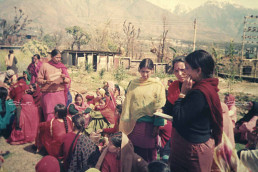
Pujya Gurudev used to describe true love as a dynamic giving, not a passive taking. Such was the exceptional love that He showered on the people of Himalayas, choosing Sidhbari as the place for the Chinmaya Tapovan ashram. So, the founding objectives of the Chinmaya Tapovan Trust was the spread of Vedanta as well as the service of those simple-hearted Pahadis.
Soon after Sandeepany HIM was inaugurated in April 1981, Pujya Gurudev initiated the efforts to serve the Pahadis in March 1982. There were no primary health care centers, and no hospital close enough for medical emergencies. So, Gurudev inaugurated a free medical dispensary, Tapovan Arogya Sadan, where Dr. Indumati Vaidya and Dr. Akhilam (Swamini Nishtananda) served. The manava seva project had struck roots with at least 30 villages benefiting at the very outset.
When Pujya Gurudev understood that women will be benefited most with proper maternal and child health care as multipurpose health workers (community nurses) got trained, He blessed and inaugurated the Chinmaya Rural Primary Health Care and Training Centre (CRPHC&TC) on April 10th, 1985.
“The people of the Himalayas, especially women, have selflessly served the wandering sadhus. This will be our repayment of ṛṣiṛiṅ (debt) to them. I want to serve them.” – Pujya Gurudev Swami Chinmayananda
The reach of the project grew by leaps and bounds as remote areas of Kangra Valley finally got medical help through six outreach health sub-centers. As more trainees became health workers, birth attendants, or village health guides, the need arose for a separate building which was completed in late 1986. The dispensary in the ashram was merged into the project.
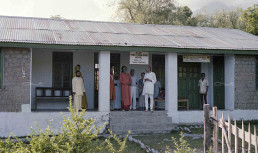
As the project grew, Dr. Kshama Metre came in November 1985, closing her pediatric practice in Delhi for good. After her magical, transformational meeting with Pujya Gurudev, she found both her Guru and her greatest calling at the same time in Sidhbari!
Chinmaya Tapovan Trust strengthened the project with the help of many ashramites. Sri Trilokinath, General Manager of CTT until 1994, assisted in the early years. The commitment of 75-year old Dr. Jayanti Mahimutra as the first director of CRPHC&TC was continued by Dr. Ramakrishna Sharma, retired Deputy Director of Health Services, Himachal Pradesh. Then, Sri K.R. Pai (Swami Ramananda) took over the project until Dr. Kshama Metre became the project director in 1987.
Pujya Gurudev’s guidance was like a mother’s care – gentle, patient, and nourishing. He emphasized on spirituality and character-building for seva to be effective.
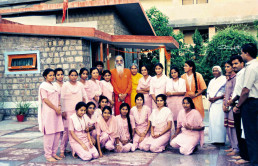
What started with maternal and child healthcare soon diversified to address the poverty, lack of education and livelihood resources, and poor awareness of hygiene, sanitation, and more. Thus evolved the acclaimed CORD – the Chinmaya Organisation for Rural Development. The empowered women became a driving force with their Mahila Mandals. CORD also motivated, mobilized, and enabled powerful community-based organizations, CBOs. The success that started in Sidhbari became a CORD saga which continues to empower not just the Pahadis but so many more across rural India.
In Sidhbari, Pujya Gurudev started a silent revolution with an expanding influence. While the rural women were learning the art of collective action and active participation, Pujya Gurudev turned His attention to the Pahadi children and youth. The Hari Hara vocational schools focused on children learning through field experiences and then getting trained in various vocations that would enrich them.
Sri Hansraj who came to Chinmaya Tapovan ashram as a youth speaks with affectionate reverence about the way his life was transformed by the Grace of Gurudev. In his words, we can hear gratitude for how Pujya Gurudev brought hope, confidence, and prosperity to the Pahadis.
Three Examples of Transformation
The following anecdotes illustrate, through an individual beneficiary’s story, how the CBOs and the four strategic principles enable CORD to transform the lives of the poor people who then mutually help each another. Moreover, the stories depict how CORD enriches various aspects of a person as a whole even though the entry point may be through any one of its program components. These excerpts are from the Mananam publication titled "Chinmaya Seva."
Pahadi Upliftment Videos
Navigation
Next Topic
Samadhi Sthal
A hallowed space in Chinmaya Tapovan, the Samadhi Sthal of Pujya Gurudev Swami Chinmayananda (1916-1993) is an inspirational altar in the ashram. It is the…
Home Page
Sidhbari Ashram
Chinmaya Tapovan ashram in Sidhbari shines as the crest-jewel of Chinmaya Mission where the Grace of the Guru awakens the thirst for Knowledge ripened with devotion.
Previous Topic
The Progress at Sidhbari
When we visit Sidhbari today, it is hard to imagine the unapproachable land that it was in the 1970s. Swami Chinmayananda’s vision made that metamorphosis in…

